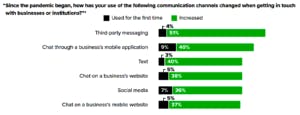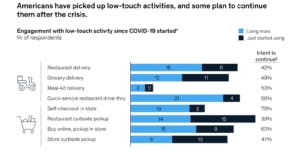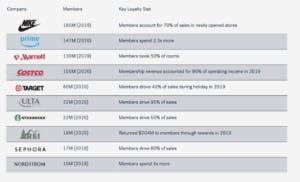Why Loyalty is More Important than Acquisition for Retailers in a Post-Covid World


In over a year of constant disruption for retailers and consumers, convenience has emerged as the thing shoppers desire most from their favorite brands. Everything we are seeing from our own data at Conversocial, A Verint Company, and reports from key industry voices like Forrester and McKinsey, is pointing towards the digital shift in consumer habits being here to stay.
This change has been a long time in the making. For all retailers the evolution of shoppers moving from brick and mortar stores was already here – 63% of shopping journeys now start online. Add a pandemic to the mix and the reliance on digital channels deepens. There’s been at least a 25% growth in online customers for a number of industries in the US during the pandemic, from groceries and food delivery to over-the-counter (OTC) medicine and home furnishings.
The natural progression of online shopping is to mobile, or m-commerce. It’s been a while since phones were just for texting, making calls and playing snake, they’re now virtually an extension of our arms, so it’s becoming the new frontier for brands to master when trying to provide the service that customers want across the buyer journey.
Covid-19 forced people into their homes in 2020, as a result, consumers are using digital channels to their own advantage and are now dictating their own buyer journey.
There’s also been a huge growth in the use of messaging channels during the pandemic, with Facebook’s Messenger platform seeing a 40% increase in traffic, and 80% of time spent on mobiles is using messaging apps. The popularity has spread into interactions with businesses – more than 1bn people now have conversations with brands over messaging channels. A Forrester/Google report even found that third-party messaging grew the most of any channel for consumer/brand interactions.

It’s exactly what we’ve been seeing on our own platform with the data from Conversocial, A Verint Company, retail brand partners. After the big spike in March 2020 of customers using private messaging to contact food retailers, the volume leveled off but remained at 3x pre-pandemic levels.

Consumers have very much seen the light. If they can shop, receive updates or have conversations with brands in the same way they chat to friends and family, why should that change just because they can go back to stores? Convenience (51%) and speed (36%) are now the most important factors when consumers choose how to communicate with brands, extending to other points on the customer lifecycle.
However, we can’t just look at the rise in conversations and assume that for traditional grocery brands communicating over messaging is the only ‘convenience’ that customers are demanding. There are rival services that have boomed during lockdowns – most significantly meal kits. Hello Fresh saw a year-on-year growth of 111% in 2020, with a turnover of nearly $4.5bn. People avoiding the grocery store was definitely advantageous for some!
And it’s not just getting someone to deliver perfectly portioned ingredients to your doorstep that grocery stores are competing with, there are increasingly more convenient options for every possible way to get your dinner.

These numbers show that there are so many options, and not just in the food industry but across retail and eCommerce, that brands really need to work harder to compete for and retain customers. Many of these competitors weren’t even rivals before the pandemic.
If a digital experience isn’t good, then going to a store used to be the only other option, but with the choices that have emerged as a result of Covid-19, losing customers because a rival’s digital journey is better is a very real concern.
“The brands of the next decade will win with loyalty, not acquisition.”
Forerunner Ventures
It’s why the quote above resonated so much with me when I was researching this article. It’s never been easier to set up an online business, and it’s also never been harder to stand out from the crowd. Facebook’s annual advertising revenue has risen from $11.5bn to $84.2bn in the last 5 years and Shopify now has 1.59m stores on its platform.
In short, it’s pretty competitive out there and with consumer habits shifting towards more digital channels, acquisition is going to be more difficult and more expensive.
The need to inspire more loyalty is actually quite good news for brands. For one, it’s cheaper to retain customers than find new ones and they’re up to 70% more likely to buy from you again. You just have to look at the revenue generated by some of the world’s largest brands from loyal customers to understand just how vital it can be.

How Can Brands Build a CX Strategy That Inspires Loyalty?
Convenience and speed are the biggest pulls in terms of how consumers choose to communicate with a brand. Also, shopping behavior for industries as diverse as medication and home furnishings is becoming more digital-focused, so using the power of private messaging channels to engage across a customer’s entire lifecycle ticks a lot of those boxes.
When it comes to actually buying a product, 68% of people are more likely to use a business with “convenient communications” to make a purchase. On platforms like Facebook Messenger, Apple Business Chat and WhatsApp (in certain regions) convenient communications can be combined with commerce. Each of the messaging apps allows brands to showcase their products and complete the purchases without having to leave the conversation.
McKinsey’s report shows that grocery delivery, in-store/restaurant collections and curbside pickups have all become more popular options during the pandemic and will continue to be. They all offer an opportunity for automated post-purchase engagements.
In the world of WISMO (where is my order) 63% of queries are before shipping, at the ‘when will you ship?’ (which I’d like to christen WWYS) stage. By asking customers to opt into proactive notifications, these questions are addressed before they’re even asked, consumers are engaged on their preferred channels and are being updated in real-time when a delivery or collection is ready.
At this stage, engagement, personalization and convenience can really kick in. Food stores competing with restaurants and meal kits could build automation that helps customers choose recipes for the week, adding the ingredients to their basket as they go. Beauty brands are able to offer products that complement previous purchases or regular virtual makeovers, all within messaging channels.
These platforms are adaptable enough for brands to create convenient customer experiences across many industries. Incorporating them into your CX strategy is about understanding which use cases will provide the most value and convenience for your customers. We’ve seen a huge amount of upheaval in the world since March 2020, including the how, when and where consumers want to shop. The brands that can inspire loyalty through convenient and personalized experiences will ultimately prosper.